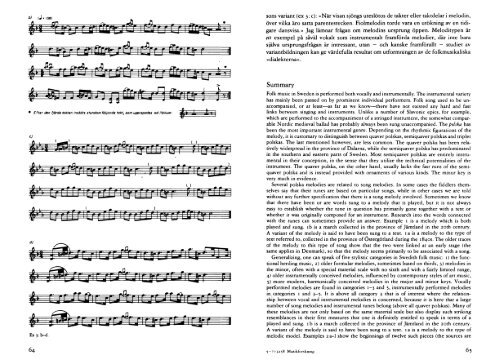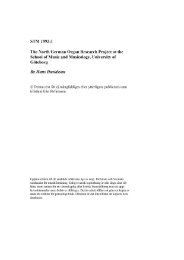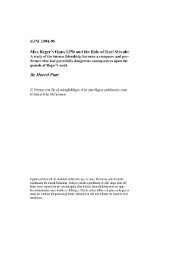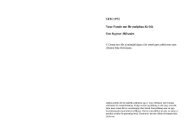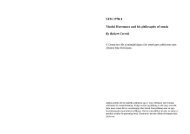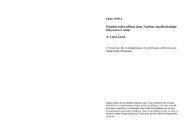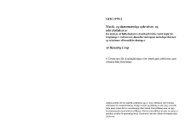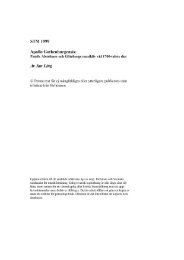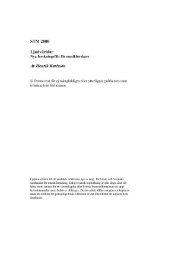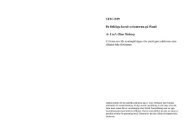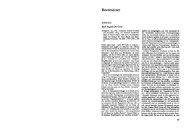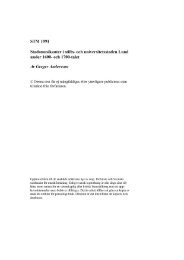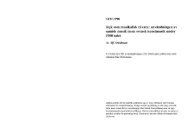Margareta Jersild - Svenska samfundet för musikforskning
Margareta Jersild - Svenska samfundet för musikforskning
Margareta Jersild - Svenska samfundet för musikforskning
You also want an ePaper? Increase the reach of your titles
YUMPU automatically turns print PDFs into web optimized ePapers that Google loves.
Efter den fjärde takten insköts stundom följande takt, sam upprepades ad libitum:<br />
Ex 3: b-d.<br />
sons variant (ex 3: c): »När visan sjöngs uteslötos de takter eller taktdelar i melodin,<br />
över vilka äro satta parentestecken. Fiolmelodin torde vara en utökning av en tidi-<br />
gare dansvisa.» Jag lämnar frågan om melodins ursprung öppen. Meloditypen är<br />
ett exempel på såväl vokalt som instrumentalt fram<strong>för</strong>da melodier, där inte bara<br />
själva ursprungsfrågan är intressant, utan - och kanske fram<strong>för</strong>allt - studiet av<br />
variantbildningen kan ge värdefulla resultat om utformningen av de folkmusikaliska<br />
»dialekterna».<br />
Summary<br />
Folk music in Sweden is performed both vocally and instrumentally. The instrumental variety<br />
has mainly been passed on by prominent individual performers. Folk song used to be un-<br />
accompanied, or at least-as far as we know-there have not existed any hard and fast<br />
links between singing and instruments. Unlike a number of Slavonic epics, for example,<br />
which are performed to the accompaniment of a stringed instrument, the somewhat compar-<br />
able Nordic medieval ballad has probably always been sung unaccompanied. The polska has<br />
been the most important instrumental genre. Depending on the rhythmic figurations of the<br />
melody, it is customary to distinguish between quaver polskas, semiquaver polskas and triplet<br />
polskas. The last mentioned however, are less common. The quaver polska has been rela-<br />
tively widespread in the province of Dalarna, while the semiquaver polska has predominated<br />
in the southern and eastern parts of Sweden. Most semiquaver polskas are entirely instru-<br />
mental in their conception, in the sense that they utilize the technical potentialities of the<br />
instrument. The quaver polska, on the other hand, usually lacks the fast runs of the semi-<br />
quaver polska and is instead provided with ornaments of various kinds. The minor key is<br />
very much in evidence.<br />
Several polska melodies are related to song melodies. In some cases the fiddlers them-<br />
selves say that their tunes are based on particular songs, while in other cases we are told<br />
without any further specification that there is a song melody involved. Sometimes we know<br />
that there have been or are words sung to a melody that is played, but it is not always<br />
easy to establish whether the tune in question has primarily gone together with a text or<br />
whether it was originally composed for an instrument. Research into the words connected<br />
with the tunes can sometimes provide an answer. Example I is a melody which is both<br />
played and sung. 1b is a march collected in the province of Jämtland in the 20th century.<br />
A variant of the melody is said to have been sung to a text. 1a is a melody to the type of<br />
text referred to, collected in the province of Östergötland during the 1840s. The older traces<br />
of the melody to this type of song show that the two were linked at an early stage (the<br />
same applies in Denmark), so that the melody seems primarily to be associated with a song.<br />
Generalizing, one can speak of five stylistic categories in Swedish folk music: I) the func-<br />
tional herding music, 2) older formular melodies, sometimes based on thirds, 3) melodies in<br />
the minor, often with a special material scale with no sixth and with a fairly limited range,<br />
4) older instrumentally conceived melodies, influenced by contemporary styles of art music,<br />
5) more modern, harmonically conceived melodies in the major and minor keys. Vocally<br />
performed melodies are found in categories 1-3 and 5, instrumentally performed melodies<br />
in categories I and 3-5. It is above all category 3 that is of interest where the relation-<br />
ship between vocal and instrumental melodies is concerned, because it is here that a large<br />
number of song melodies and instrumental tunes belong (above all quaver polskas). Many of<br />
these melodies are not only based on the same material scale but also display such striking<br />
resemblances in their first measures that one is definitely entitled to speak in terms of a<br />
played and sung. 1b is a march collected in the province of Jämtland in the 20th century.<br />
A variant of the melody is said to have been sung to a text. 1a is a melody to the type of<br />
melodic model. Examples 2a-l show the beginnings of twelve such pieces (the sources are


